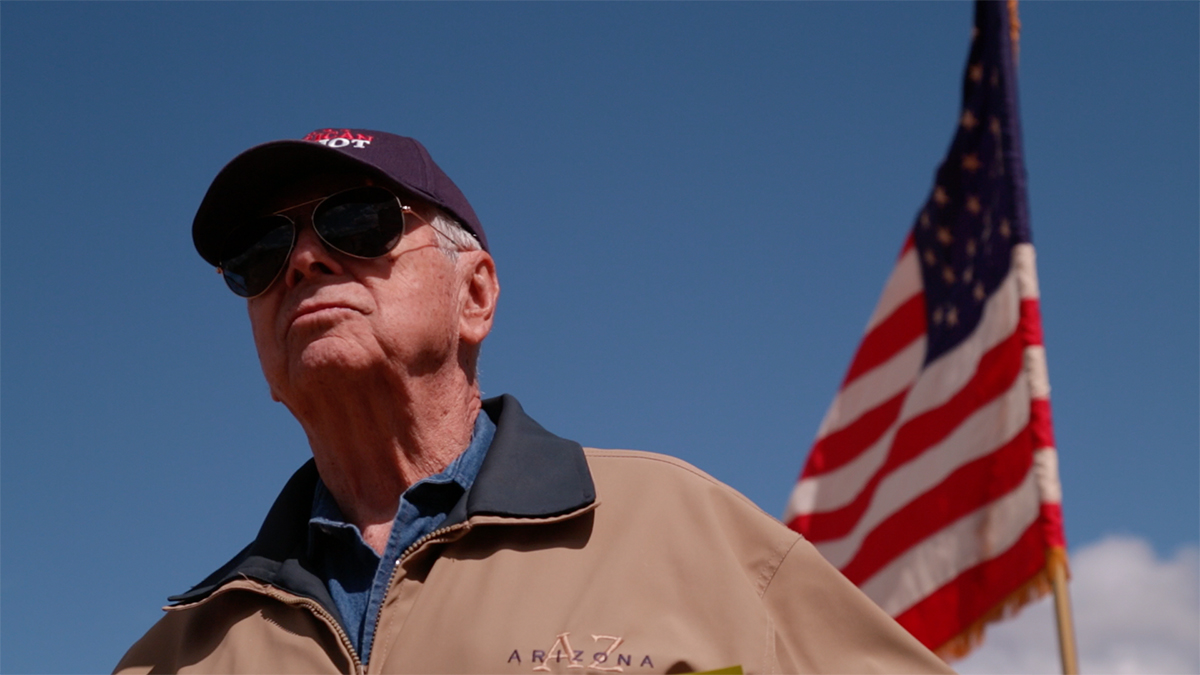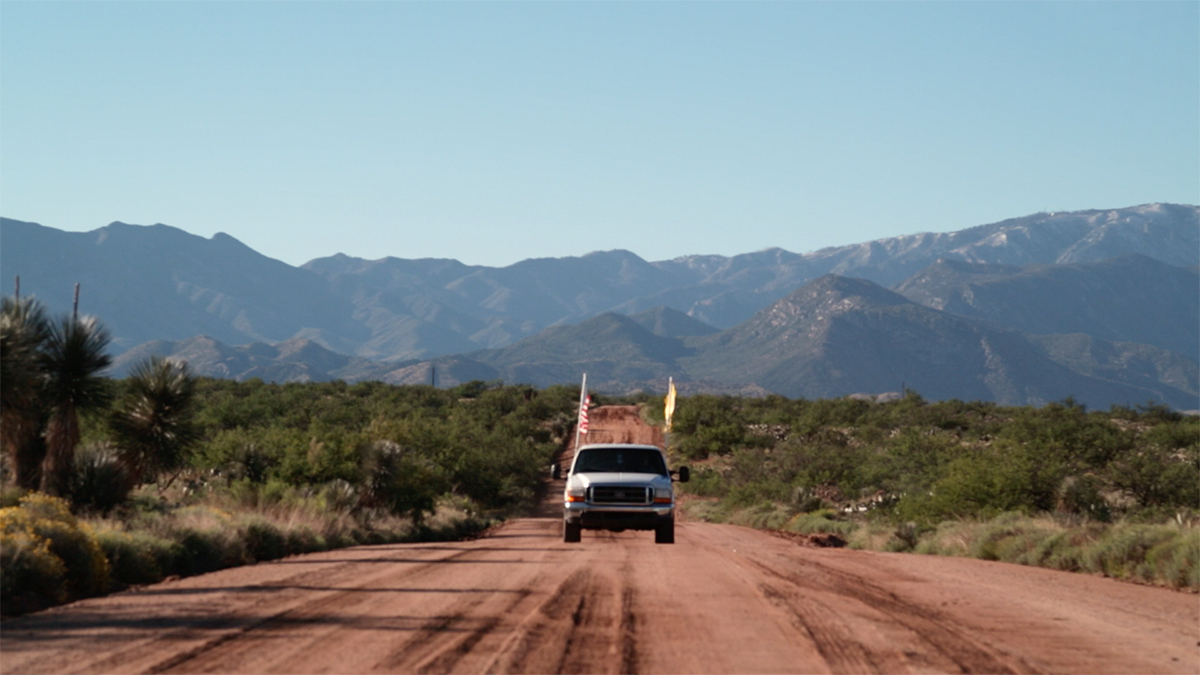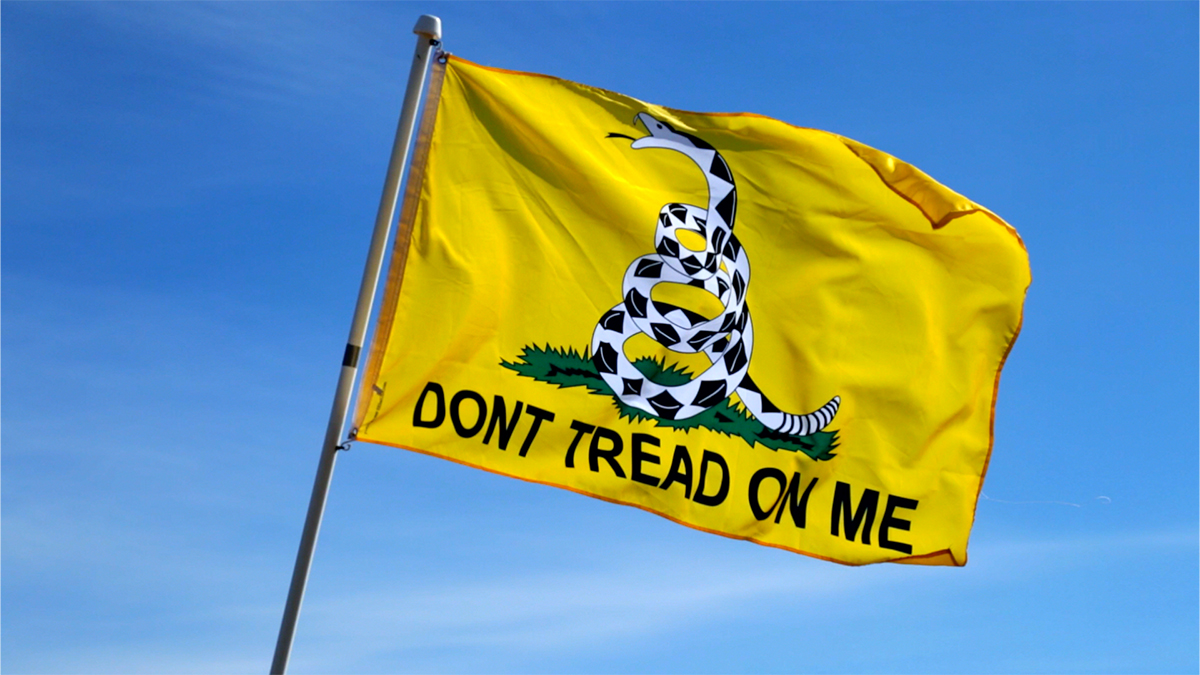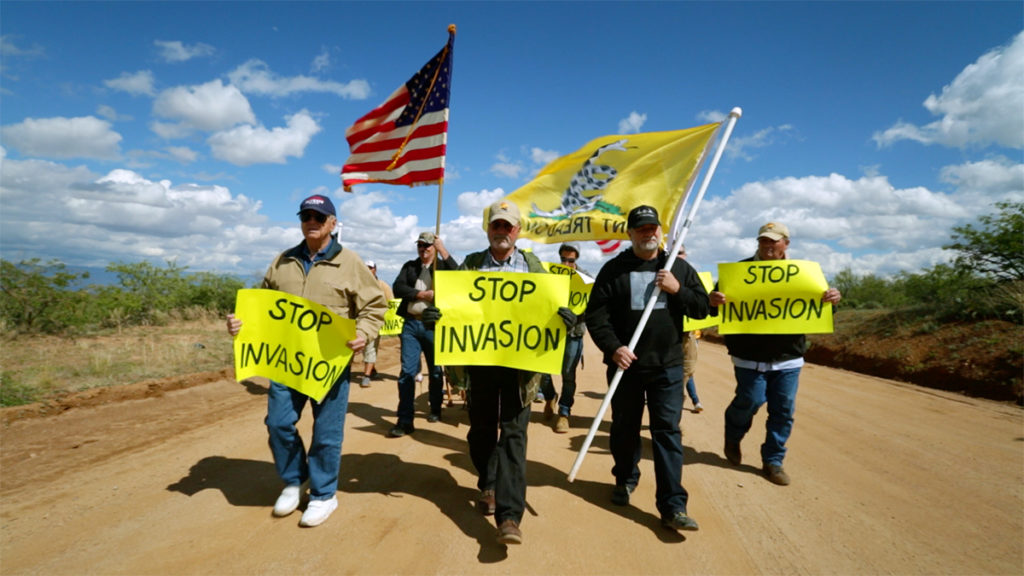by Julie Poitras Santos
A pick-up truck is gunning repeated, tight, clockwise circles in the desert, throwing dirt behind it, carving a red-brown circle in the earth. From the tailgate fly the United States flag and the Gadsden flag from the American Revolutionary War era, Don’t Tread on Me. The sound of the truck, its pulsing accelerations, grinds in your ears. The camera shifts inside and from our spot as passenger, we see the driver leaning consistently into the turn, working gas and wheel, grunting as he maneuvers the speeding vehicle. From off screen, he picks up a pistol in his right hand and we see him reach across his left side to shoot randomly out the open window. He’s shooting blanks, and from outside of the cab, the vision of the circling truck is punctuated by quiet pops. From inside the truck, we see the driver shoots chaotically, emotionally, as if gesticulating wildly in aggressive argument. No one else is around.
This scene is from Yoshua Okón’s Oracle, a multi-channel video on view at Colby College Art Museum this spring. Okón’s video works blur the lines between documentary, reality, and fiction, asking participants and viewers to engage in sociological experiments that reveal discomforting questions. The work takes as its focus protests in Oracle, Arizona, home of the closed Oracle Ridge Copper Mine.1 In 2014, a growing influx of migrants from Guatemala, Honduras, and El Salvador reached a crisis point. Vast numbers of children fleeing accelerating violence in their home countries crossed our southern border, seeking asylum in the United States. The small town of Oracle became a hot-point in the national immigration debate at the time. Groups of protesters and counter-protesters gathered in resistance and support of government plans to transport about forty immigrant children to a local facility for youth services. In 2015, Okón asked a volunteer organization to restage this protest that took place July 2014 in Oracle.
While protesters and counter protesters were present in the town, Okón’s video regards only a small group of anti-immigrant protesters. We see the man in his truck, isolated in his obsessional circles, and a small band of stoic protesters bearing flags and signs that say “STOP INVASION” marching down a deserted road in silence. Robbed of their target, the group seems feeble and trifling, a reminder that a small number of voices can operate to radically alter our political imagination. While the Tucson Weekly reported that by “8:30am, it [was] for the most part a peaceful event dominated by supporters,” Okón turns his lens on the anti-immigrant group to reveal their context and actions, and in the process subtly questions their motives.

Okón collaborates closely with actors to create works that investigate contested political situations such as this one. He frequently works with amateur actors, and often with the subjects of his investigation themselves. In his 2011 work, Octopus, the Guatemalan Civil War is reenacted in the parking lot of a Home Depot in Los Angeles, performed by actual combatants who fought in the war in the 1990s. The actors were recent undocumented immigrants who had gathered in the parking lot to look for work as day laborers. The title of the video derives from the informal nickname given to the United Fruit Company (UFCO), the US company located in Guatemala largely tied with the 1954 CIA coup that ousted the democratically elected government of Jacobo Arbenz on the premise that he was soft on Communism, and thus instituted years of brutal CIA-backed military rule. This destabilization of the elected government, and continued US involvement throughout the 80s and 90s, initiated a nearly four-decade-long cycle of violence and repression in which an estimated 200,000 people were killed.
In Oracle, Okón worked with a militia group, the Arizona Border Protectors, to reenact their protests from July 2014, and also to create new scenes based in their nationalist philosophies. In one scene the flag waving truck drives down an empty stretch of road; we hear the sound of a gun and see dust kicked up by bullets entering the scrub brush. In another scene back at the circle, three trucks now gun around that tight geometry creating clouds of dust that ultimately obscure the participants and their trucks. A sign on an oddly suburban iron border fence claims, “THE PRICE OF FREEDOM IS ETERNAL VIGILANCE.” Another sign asks, “DOES MY AMERICAN FLAG OFFEND YOU? CALL 1 800 LEAVE THE USA.” A Border Protector shoots his pistol out the window — under his arm with the swagger of a cowboy — and whoops, “yeeeeee-haw!” The doctrine of manifest destiny feels still alive and well in this wild West.
And indeed, in one scene a group of men gather atop a hill of boulders and struggle to plant the American flag. Using a length of slightly flexible PVC pipe they wedge it between the rocks; there is a moment when the flag falters, and they struggle to erect the symbol. The desert landscape spreads vast around them. Moments such as these in Okón’s video strike me as ironic in the face of conversations regarding borders and strident fears conveyed by anti-immigrant groups. The moment clearly mimics the famous photograph by Joe Rosenthal of US marines raising a flag atop Mount Suribachi on February 23, 1945, in the battle for Iwo Jima. As with that moment during WWII, the actors here aim to signal the capture of territory and in doing so, enact a centuries old symbolic colonial trope for staking territorial claim. Here, the actors suggest their land is under attack and perhaps reenact the boundary determinations of the 1848 Treaty of Guadalupe Hidalgo.

The connection to the US Central Intelligence Agency so important to Okón’s Octopus is also important to Oracle. While the projection at Colby comprises two staggered videos, the four-channel version includes footage of a choir of Guatemalan children, backs to the camera, singing a United States military hymn rewritten to tell the history of the US invasion of Guatemala. As Okón describes, “The original hymn glorifies US invasions around the world. For the new version, the children narrate the US invasion to Guatemala placing special emphasis in the complicity of the government with transnational corporations.” The Guatemalan choir, represented in this installation by a large photograph, bear the letters “C-I-A” across their backs. The complicity of transnational corporations — in Octopus, the UFCO — is shown in Oracle with the Oracle Technology Network. Their advertising logo streams across a segment of the video, appearing clearly as signifier of the multinational tech corporation. Further investigation reveals the deep connections OTN shares with the CIA. Former Attorney General John Ashcroft’s consulting firm, for example, reportedly collected $220,000 from Oracle Corporation in 2005; and Oracle won a Department of Justice approval of a multibillion-dollar acquisition less than a month after hiring Ashcroft. Former Director of the Central Intelligence Agency and Former US Secretary of Defense Leon Panetta is currently on the Oracle board.
Okón’s work navigates the tradition of re-performance, and particularly calls to mind the popular practice of battle reenactments that can serve as history lessons — reinforcing historical narratives told by victors, for example, or retelling history from differing perspectives — or as acts of remembrance or mourning for soldiers who lost friends at war. In this way, Okón’s work also recalls the work of An-My Lê. In her series, Small Wars, Lê photographed Vietnam War reenactors staging theatrical battles in the woods of Virginia. Karen Irvine, Curator at the Museum of Contemporary, describes Small Wars:”Lê was often asked to participate in the reenactments, her ethnicity presumably adding an element of authenticity to the make-believe. Over the course of the project she acted various roles ranging from that of a translator to, disconcertingly, a member of the Viet Cong.”2 Disconcerting, indeed. Okón’s work reveals no such participation, but one does wonder about his gaze as maker. How do the actors understand this reenactment? How does Okón present his project to them? Do they know Okón is Mexican? An-My Lê was careful not to mock the reenactors in her images, allowing the viewer to develop their own opinions. Okón similarly retains distance from the protagonists’ purposes, and lets the camera framing do the work for him, provoking his viewers to make their own assessment. Where Lê’s work uses the style of documentary photography, Okón’s video engages more with the mythic Western. The Western is a filmic thematic that, while it relishes morality tales and adventure, problematically embraces masculine bravado and simultaneously demeans native and other inhabitants.
The newspapers from the July protests in Oracle, AZ, are filled with jingoistic jargon and overtly racist commentary. “We’re concerned about our community, about the gang members that might be among these kids, and the diseases they might bring,” one protester says. “I’m protesting the invasion of the United States by people of foreign countries. This is about the sovereignty of our nation,” another Oracle resident explains. “Who knows who these boys are, whether they’re choirboys or MS-13 gang members?” a third says. The actors in Oracle, as well, voice their nationalism and fear that the children arriving from Central America put their communities at risk. While the actor in Okón’s piece suggests that immigrants might enter the US by “proper” channels, he seems particularly incognizant or immune to the fact that the children are in fact refugees fleeing violence, seeking asylum. “You’re not going to like that…” grumbles the man driving in circles, exerting himself now with an AR-15 slung from right shoulder across his chest and shooting out the window, “You’re opening up hell… and we’re not going to tolerate it.”

As with Octopus, Oracle reenacts a past event but by Okón’s framing points toward opaque systems and questions our participation in them, in process revealing — if you look into it — histories many don’t know about, recall, or care to learn. The work demands a deep engagement from its viewer, but runs the risk of reaffirming established lines in the sand. Okón’s work puts us in the uneasy position of witnessing a gleeful — if deflated — reenactment of racism and nationalism. But it also could be seen to affirm fears and redraw “battle lines” for some viewers. The truck circles in particular seem to evidence a broken record, but also the psychological spinning of fervent anxieties. These skirmishes “on the ground” repeat ad infinitum while multinational corporations fly easily across borders, mining the terrain below.
***
A recurring segment within Oracle has the camera focused on the ground. Strewn liberally with bullet shells, a flurry of ants scurries around on the rocky red-brown soil. A rest from the action above, this activity too seems labored and frantic. Urgent. The ants crisscross the borderless terrain, for them the border holds no meaning.
Yoshua Okón’s Oracle is on view at Colby College Museum of Art though May 1, 2018.
Colby College Museum of Art
5600 Mayflower Hill, Waterville, Maine | 207.859.5600
Open Tuesday–Saturday 10am–5pm and Sunday 12–5pm. Open on Thursdays until 9 pm during the academic year.
- Oracle Ridge Copper Mine is owned by a Vancouver, Canada based company. An underground mine, Oracle Ridge operated until 1996 when it closed primarily due to low copper prices. http://www.oracleminingcorp.com/ ↩
- Museum of Contemporary Photography, An-My Lê: Small Wars: http://www.mocp.org/exhibitions/2006/10/an-my-le-small-wars.php ↩
Julie Poitras Santos is a visual artist based in Portland, Maine. Also a writer, her research interests include the relationship between site, story and mobility, and often involve areas where art and language intersect. She works as Director of Exhibitions at the Institute of Contemporary Art at Maine College of Art.

